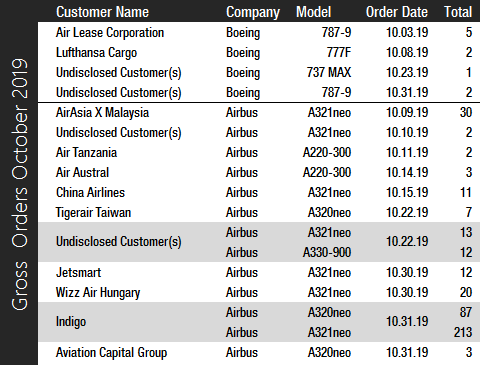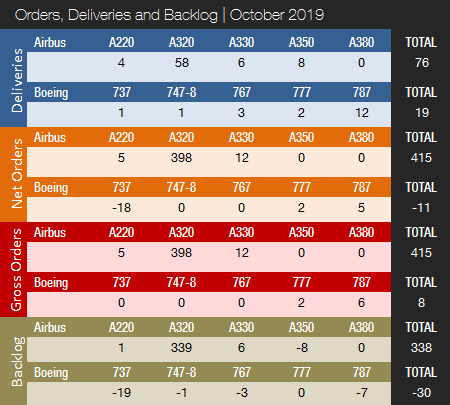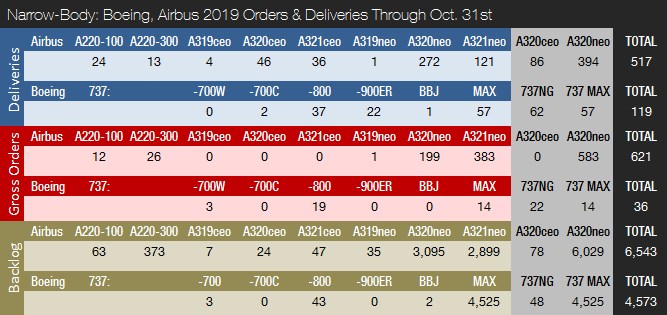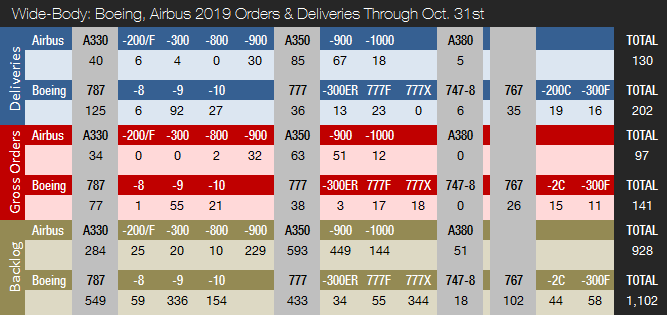Airbus Books Impressive 415 Net New Orders Thanks to Large IndiGo Narrowbody Deal
by J. Kasper Oestergaard, European Correspondent, Forecast International.

In October 2019, Boeing and Airbus delivered 19 and 76 commercial jets, respectively, compared to 57 and 81 deliveries in the same month last year. With just 321 deliveries to date this year, Boeing is 304 shipments behind last year’s total for the first 10 months of the year. This year, Airbus delivered a total of 647 jets from January to October, compared to 584 during the same period last year. In 2018, Boeing delivered 806 jets (763 in 2017), with Airbus handing over 800 (718 in 2017).
Boeing’s deliveries have taken a severe hit following two 737 MAX crashes and the subsequent deliveries halt and grounding of the fleet. In March, Boeing decided to suspend all deliveries of 737 MAX jets. The crashes were almost certainly caused by the aircraft’s Maneuvering Characteristics Augmentation System (MCAS), which suddenly activated in response to erroneous angle of attack information. In October, Boeing delivered just one 737NG.
Boeing is producing 737 MAX jets at a reduced rate of 42 aircraft per month, thereby building up an inventory of aircraft ready to be shipped. During 2018, Boeing raised its 737 production rate to 52 and planned to further increase production to 57 per month by the middle of this year. Producing the 737 MAX at a reduced rate allows Boeing to prioritize additional resources to focus on returning the 737 MAX to flight.
In April, the Federal Aviation Administration (FAA) established a Boeing 737 MAX Joint Authorities Technical Review (JATR), comprised of a team of experts from the FAA, NASA, and international aviation authorities. Since then, Boeing has worked with the FAA and the JATR and has tested updates to its 737 MAX software during hundreds of flights. On October 11, the JATR submitted its Observations, Findings, and Recommendations. In its report, the JATR criticizes both Boeing and the FAA for their assessment and approval of the design of the 737 MAX automated flight control system.
While the FAA and other regulatory authorities will determine the timing of certification and return to commercial service, on October 11, Boeing announced it continues to target FAA certification of the 737 MAX flight control software updates during this quarter. According to Boeing, it is possible that MAX deliveries to airline customers could resume in December.
In parallel, Boeing is working toward final validation of the updated training requirements. Final validation must occur before the 737 MAX returns to commercial service. The company expects the process to begin in January.
To date, Boeing has delivered a total of 387 737 MAX jets. Two hundred and fifty-six 737 MAX jets were delivered in 2018, up from 74 in 2017. In October, Boeing also delivered one 747, three 767s, two 777s, and 12 787s. Recently, Boeing raised the monthly Dreamliner production rate to 14 aircraft. Boeing has handed over 125 787s year-to-date. The company delivered 145 787s in 2018, up from 136 in 2017.
In October, Airbus delivered four A220s, 58 A320s (2 ceo / 56 neo), six A330s, and eight A350s. Airbus recently increased the official A320 production rate to 60 aircraft per month. The company is targeting an additional raise to 63 jets per month from 2021. In 2018, Airbus delivered a total of 386 A320neo Family aircraft, up from 181 and 68 in 2017 and 2016, respectively.
October marked Airbus’ 1,000th A320neo Family aircraft delivery. Airbus has delivered 85 A350s year-to-date, having shipped 93 A350s in 2018, up from 78 in 2017. Recently, Airbus increased the monthly production rate to 10. Airbus is considering a further increase to 13 A350s per month but has not announced a date yet.
With the ramp-up of A350 XWB deliveries combined with a higher A320 production rate, Airbus has nearly eliminated Boeing’s deliveries lead in recent years. Following the tragic 737 MAX events, Airbus is almost certain to deliver more aircraft than Boeing this year.
Turning to the orders race, Boeing had a slow month in October. Logging 10 gross orders, all except one were for 777 and 787 widebody jets (21 cancellations => net of -11). Boeing’s October bookings included five 787-9s for Air Lease Corporation, two 777Fs for Lufthansa Cargo and two 787-9s, and one 737 MAX for undisclosed customers. Year-to-date, Boeing has accumulated 177 gross orders (272 cancellations => -95 net new orders). For the full year 2018, Boeing booked 893 net new orders (1,008 gross orders).

Airbus logged an impressive 415 gross orders in October alone, with no cancellations reported.
IndiGo ordered 213 A321neos and 87 A320neos, making it one of Airbus’ largest-ever aircraft orders with a single airline operator. This order comprises a mix of A320neo, A321neo, and A321XLR aircraft and takes IndiGo’s total number of A320neo Family orders to 730.
The A321 was popular among airlines in October. Air Asia X ordered 30 of this type. Wizz Air ordered 20. An undisclosed customer ordered 13. JetSmart ordered 12, and China Airlines ordered 11.
The only widebody order in October was 12 A330-900s for an undisclosed customer. Additionally, during October, Spirit Airlines signed an MoU (not a firm order) for up to 100 A320neo Family jets.
For 2019 to date, Airbus reports 718 gross orders (176 cancellations => net of 542). Of these cancelations, 31 were due to Emirates’ decision earlier this year to reduce its A380 order book. This forced Airbus to announce it will cease A380 production in 2021. In 2018, Airbus landed a total of 747 net new orders (831 gross orders), thereby losing the 2018 orders race, as Boeing had accumulated 893 net new orders. Airbus had retained an orders lead over its rival every year since 2012.
On October 31, 2019, Airbus’ backlog was 7,471 jets. Of these, 6,543 (88%) were A220 and A320ceo/neo Family narrowbodies. The company set its all-time backlog record high of 7,577 jets in December 2018.
Meanwhile, by the end of October 2019, Boeing’s backlog (total unfilled orders before ASC 606 adjustment) was 5,675 aircraft. Of these, 4,573 (81%) were 737 NG/MAX narrowbody jets. Boeing set its all-time backlog high of 5,964 aircraft in August 2018.
The number of Airbus aircraft to be built and delivered represents nine point three years of shipments at the 2018 production level. In comparison, Boeing’s backlog would last “only” seven years.
This year to date, Boeing’s book-to-bill ratio – calculated as orders divided by deliveries – is negative, as cancellations have outpaced orders. Airbus’ book-to-bill ratio is 0.84. In 2018, Boeing boasted a book-to-bill ratio of 1.11, with Airbus at 0.93. In 2017, Boeing booked 921 net new orders, for a book-to-bill ratio of 1.20. That same year, Airbus booked 1,109 net new orders, for a book-to-bill ratio of 1.54.
2019 Forecast
Forecast International’s Platinum Forecast System® is a breakthrough in forecasting technology that – among many other features – provides 15-year production forecasts. The author has used the Platinum Forecast System® to retrieve the latest delivery forecasts. For 2019, Forecast International’s analysts expect Boeing and Airbus to deliver 707 and 818 large commercial jets, respectively. Prior to the 737 MAX crash and the subsequent grounding of the fleet and temporary cut in the production rate, the forecasted 2019 total for Boeing was 904. These are the latest “live” forecast figures (adjusted frequently by our analysts as new information comes in). These figures exclude militarized variants of commercial platforms, such as Boeing’s P-8 Poseidon, KC-46 and KC-767 tankers, the C-40, and Airbus’ A330 MRTT tanker program.
Prior to the second 737 MAX crash, in connection with the release of its 2018 earnings report in late January, Boeing announced it was targeting between 895 and 905 commercial jet deliveries in 2019, a 12-13% increase from 2018. Boeing has yet to announce a revised figure. The company is likely awaiting the 737 MAX’s return to service before providing an updated guidance. On February 14, Airbus announced that it aims for 880 to 890 commercial aircraft deliveries in 2019, equal to a 10-11% increase from 2018.




Note: Boeing 777-300ER orders include one 777-200LR. The 777-300ER backlog includes two 777-200LRs.


Joakim Kasper Oestergaard is Forecast International’s AeroWeb and PowerWeb Webmaster and European Editor. In 2008, he came up with the idea for what would eventually evolve into AeroWeb. Mr. Oestergaard is an expert in aerospace & defense market intelligence, fuel efficiency in civil aviation, defense spending and defense programs. He has an affiliation with Terma Aerostructures A/S in Denmark – a leading manufacturer of composite and metal aerostructures for the F-35 Lightning II. Mr. Oestergaard has a Master’s Degree in Finance and International Business from the Aarhus School of Business – Aarhus University in Denmark.
References:
- http://www.boeing.com/commercial/#/orders-deliveries
- https://www.airbus.com/aircraft/market/orders-deliveries.html
- https://www.faa.gov/news/updates/?newsId=93206
- https://www.airbus.com/newsroom/press-releases/en/2019/10/indigo-signs-for-300-a320neo-family-aircraft.html
- https://www.airbus.com/newsroom/press-releases/en/2019/10/airbus-marks-its-1000th-a320neo-family-aircraft-delivery.html
- https://www.boeing.com/commercial/737max/737-max-update.page
- https://news.yahoo.com/1-boeing-did-not-adequately-185601071.html
- https://www.faa.gov/news/media/attachments/Final_JATR_Submittal_to_FAA_Oct_2019.pdf
- https://www.seattletimes.com/business/boeing-aerospace/international-regulator-report-slams-boeing-faa-over-737-max-design-and-approval/
- https://boeing.mediaroom.com/news-releases-statements?item=130556
- https://www.airbus.com/newsroom/press-releases/en/2019/10/spirit-airlines-signs-mou-for-up-to-100-a320neo-family-aircraft.html
A military history enthusiast, Richard began at Forecast International as editor of the World Weapons Weekly newsletter. As the Internet grew in importance as a research tool, he helped design the company's Forecast Intelligence Center and currently coordinates the EMarket Alert newsletters for clients. Richard also manages social media efforts, including two new blogs: Defense & Security Monitor, covering defense systems and international issues, and Flight Plan, which focuses on commercial aviation and space systems. For over 30 years, Richard has authored the Defense & Aerospace Companies, Volume I (North America) and Volume II (International) services. The two books provide detailed data on major aerospace and defense contractors. He also edits the International Contractors service, a database that tracks all the contractors involved in the programs covered in the FI library. More recently he was appointed Manager, Information Services Group (ISG), a new unit that encompasses developing outbound content for both Forecast International and Military Periscope.




